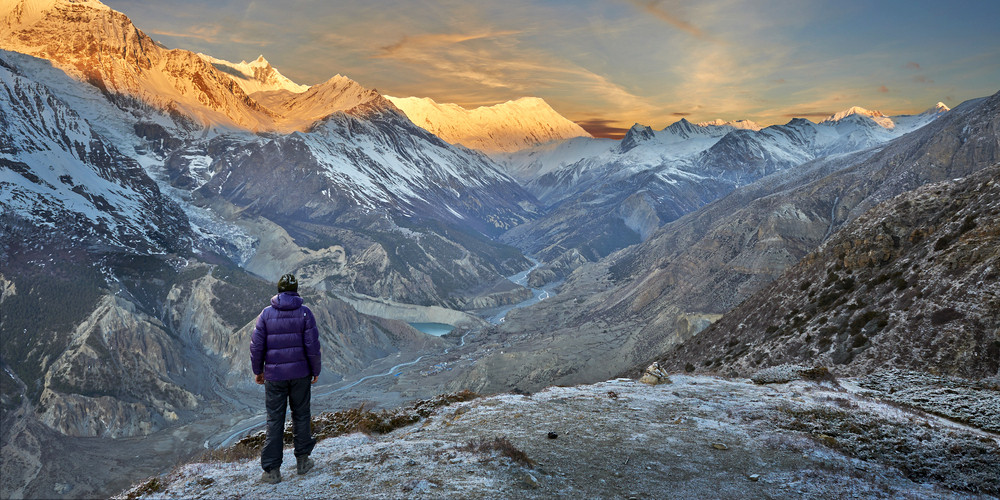Why Autumn?
Autumn is considered the prime trekking season in Nepal for several compelling reasons:
-
Stable Weather Conditions: Autumn, spanning from late September to late November, is characterized by stable, dry weather. The monsoon rains have ended, reducing the risk of landslides and floods, and before the harsh winter sets in, making it the ideal window for clear and safe trekking conditions.
-
Excellent Visibility: After the monsoon season, the dust and haze are washed away, leaving the skies exceptionally clear. This results in spectacular visibility, offering unobstructed views of the Himalayan peaks, which is a major draw for trekkers looking to experience the breathtaking scenery.
-
Moderate Temperatures: The temperatures during autumn are typically mild, making daytime treks comfortable. It is neither too hot at lower elevations nor too cold at higher altitudes, which can be a concern in late winter.
-
Cultural Vibrancy: Autumn coincides with some of Nepal’s most significant festivals, including Dashain and Tihar. Trekkers not only get to explore the landscapes but also have the unique opportunity to witness and participate in these cultural celebrations, adding a rich, cultural dimension to their adventure.
-
Flora and Fauna: The post-monsoon freshness brings out the vibrant colors of the flora, and the cooler temperatures are more comfortable for the local fauna, making wildlife sightings more likely for nature enthusiasts.
These factors make autumn the best time for trekking in Nepal, providing trekkers with a pleasant climate, clear views, safe trails, and a rich tapestry of cultural and natural beauty.
Popular Autumn Treks in Nepal
Autumn is the peak trekking season in Nepal, providing ideal conditions for some of the world's most famous treks. Here are some of the most popular treks to consider during this season:
Everest Base Camp Trek
The Everest Base Camp Trek is one of the most famous and sought-after hiking routes in the world, providing an exhilarating adventure to the base of the highest peak on Earth, Mount Everest. This trek not only challenges the trekkers physically but also offers an immense reward with its stunning landscapes, rich Sherpa culture, and panoramic views of some of the highest mountains in the world.
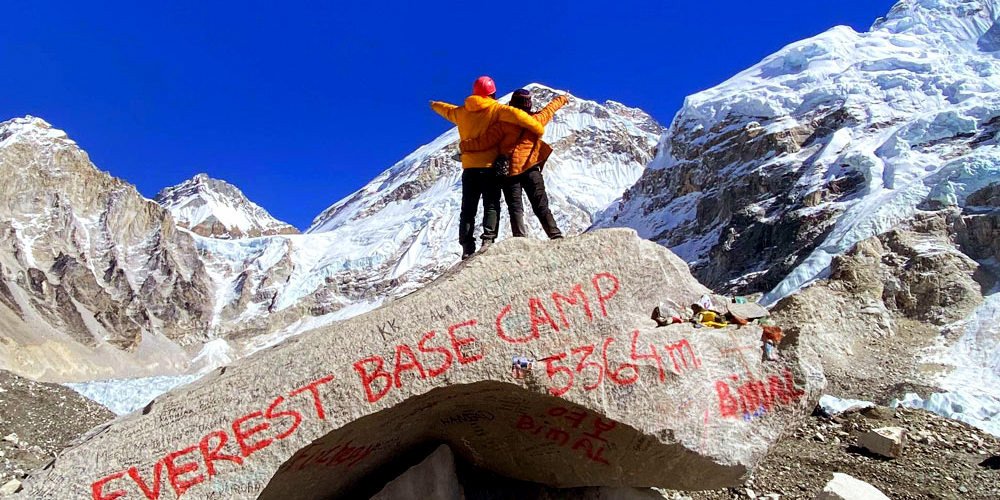
Key Features of the Everest Base Camp Trek
-
Duration: Typically, the trek takes about 12 to 14 days starting from Lukla, the gateway town where most trekkers fly into from Kathmandu.
-
Altitude: The trek reaches its highest point at Kala Patthar (5,545 meters or 18,192 feet), with the base camp itself at 5,364 meters (17,598 feet).
-
Difficulty: It is considered a strenuous trek due to its high altitude, cold weather, and the physical demands of walking roughly 5-8 hours a day on rugged mountainous terrain.
Route Highlights
-
Lukla Airport: Starting point of the trek, known as one of the most thrilling airports in the world.
-
Namche Bazaar: Often referred to as the gateway to the high Himalayas, this bustling Sherpa town offers trekkers a chance to acclimatize and explore local culture and mountain life.
-
Tengboche Monastery: Situated at 3,867 meters (12,687 feet), this is the spiritual center of the Khumbu region where trekkers can observe Buddhist monks in prayer and see the ornate artwork of the monastery.
-
Dingboche and Lobuche: Villages that offer critical acclimatization stops with close-up views of several high peaks.
-
Everest Base Camp: The highlight of the trek, providing views of the notorious Khumbu Icefall and a sense of accomplishment that comes with reaching the base of the world's tallest mountain.
-
Kala Patthar: Provides the most accessible point to view Mount Everest from base to peak along with spectacular panoramic views of the surrounding mountains.
Best Time to Trek: The best times to undertake the Everest Base Camp Trek are during the pre-monsoon (March to May) and post-monsoon (late September to November) periods. Autumn, particularly, is favored for its stable weather and clear skies, providing the best conditions for trekking and photography.
The Everest Base Camp Trek is more than just a trek; it is a journey into the heart of the Himalayas, filled with awe-inspiring landscapes and vibrant Sherpa culture, offering a profound sense of adventure and accomplishment.
Annapurna Base Camp Trek
The Annapurna Base Camp Trek is one of the most popular treks in Nepal, known for its spectacular vistas and diverse landscapes, providing trekkers with an authentic insight into rural Nepali life alongside breathtaking mountain scenery. This trek routes through lush rhododendron forests, terraced rice paddies, high-altitude landscapes, and ethnic villages, under the magnificent panorama of the Annapurna range.
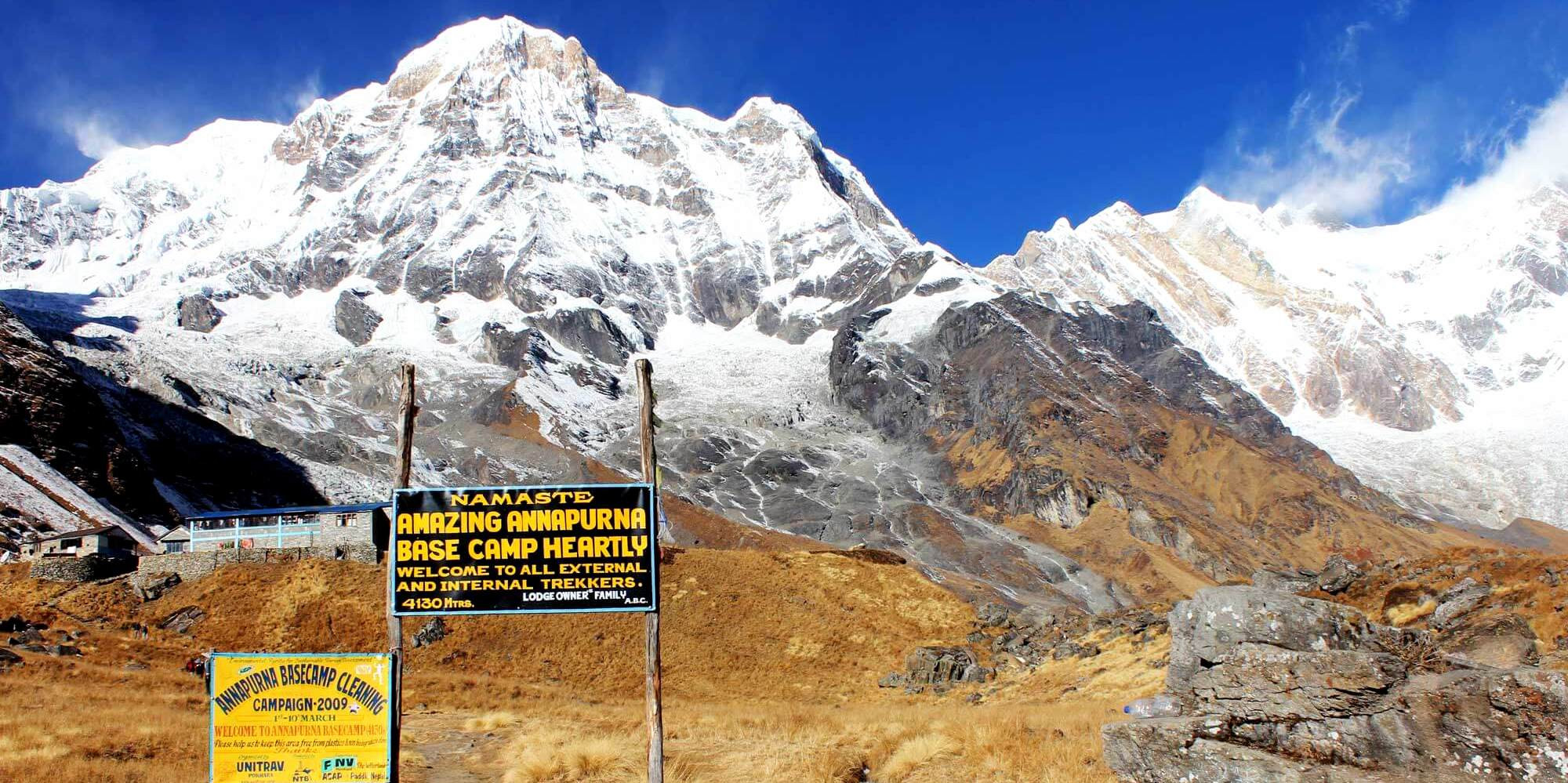
Key Features of the Annapurna Base Camp Trek
-
Duration: The trek usually takes about 7 to 12 days depending on the chosen route and pace.
-
Altitude: The base camp itself is located at an elevation of 4,130 meters (13,549 feet).
-
Difficulty: It is considered moderate; it's less strenuous than the Everest Base Camp trek but still requires a good level of physical fitness due to the daily walking times and elevation gain.
Route Highlights
-
Pokhara: The trek often begins or ends in Pokhara, a scenic lakeside city that's also a hub for adventurers seeking trekking, paragliding, and boat rides on Phewa Lake.
-
Ghorepani and Poon Hill: Offering one of the most famous viewpoints in the Annapurna region, Poon Hill provides a spectacular sunrise view of the entire Annapurna and Dhaulagiri mountain ranges.
-
Chhomrong: A beautiful village that offers close-up views of Annapurna South and the famed Machapuchare (Fishtail Mountain), acting as a gateway to the high mountains.
-
Machapuchare Base Camp: Not an actual base camp in the mountaineering sense, as climbing the mountain is prohibited, but a significant stop with outstanding mountain views.
-
Annapurna Base Camp (ABC): The ultimate destination offers an amphitheater of high Himalayan peaks, including Annapurna I, Annapurna South, Hiunchuli, and others, encircling the base camp.
Best Time to Trek: The Annapurna Base Camp Trek is best undertaken during the autumn (September to November) and spring (March to May) seasons. Autumn provides clear skies, stable weather, and the best mountain views, making it an ideal time for trekking.
The Annapurna Base Camp Trek not only challenges trekkers physically but also engages them with its cultural richness and stunning natural beauty, offering a fulfilling and memorable trekking experience.
Annapurna Circuit Trek
The Annapurna Circuit Trek is renowned for its incredible variety in scenery and culture, making it one of the most popular and comprehensive trekking routes in Nepal. This trek encircles the entire Annapurna massif, traversing a variety of landscapes from lush subtropical forests and paddy fields to high-altitude plateaus and crossing one of the highest and most famous trekking passes in the world.
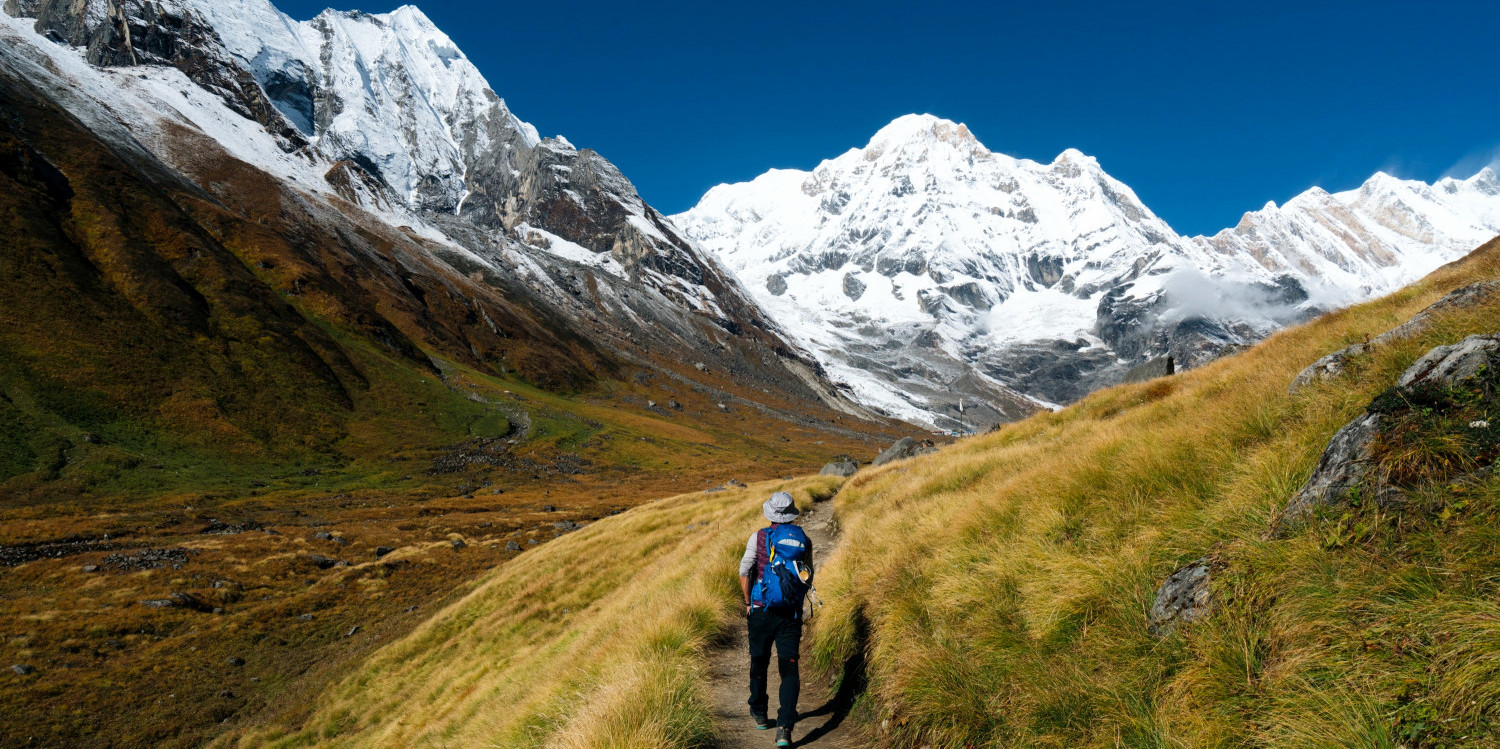
Key Features of the Annapurna Circuit Trek
-
Duration: The trek typically takes about 12 to 21 days, depending on the starting point, route variations, and trekking pace.
-
Altitude: The highest point of the trek is the Thorong La Pass, which reaches an elevation of 5,416 meters (17,769 feet).
-
Difficulty: The trek is considered moderate to challenging, suitable for relatively fit individuals due to its duration and the high altitude crossing.
Route Highlights
-
Besisahar: Traditionally the starting point for the circuit, Besisahar offers a gentle introduction to the landscapes and cultural diversity of the region.
-
Manang: A beautiful, culturally rich village that serves as an essential acclimatization stop before tackling the Thorong La Pass.
-
Thorong La Pass: The highest point and the most challenging part of the trek, offering breathtaking views and a significant sense of achievement upon crossing.
-
Muktinath: After descending from Thorong La, trekkers reach Muktinath, an important pilgrimage site for both Hindus and Buddhists, known for its eternal flame and 108 water spouts.
-
Jomsom: A popular wind-swept town known for its apples and the gateway to many other trekking routes in the Mustang region.
-
Marpha: A charming village famous for its apple orchards and local apple brandy.
-
Tatopani: Known for its natural hot springs, a perfect place to relax sore muscles from the long days of trekking.
-
Poon Hill: An optional detour that offers one of the best panoramic views of the entire Annapurna range, especially at sunrise.
Best Time to Trek: The Annapurna Circuit Trek is best undertaken during the spring (March to May) and autumn (September to November). These seasons offer the clearest skies and the most stable weather conditions, crucial for crossing the high Thorong La Pass safely.
The Annapurna Circuit Trek offers an immersive experience into the natural and cultural landscapes of Nepal, providing an unforgettable adventure for those who undertake it.
Langtang Valley Trek
The Langtang Valley Trek is a compelling journey into one of Nepal’s most beautiful yet less frequented trekking regions, offering a blend of Himalayan landscapes and fascinating cultural experiences. Located relatively close to Kathmandu, this trek is ideal for those looking to explore the majestic mountains without venturing too far from the capital.
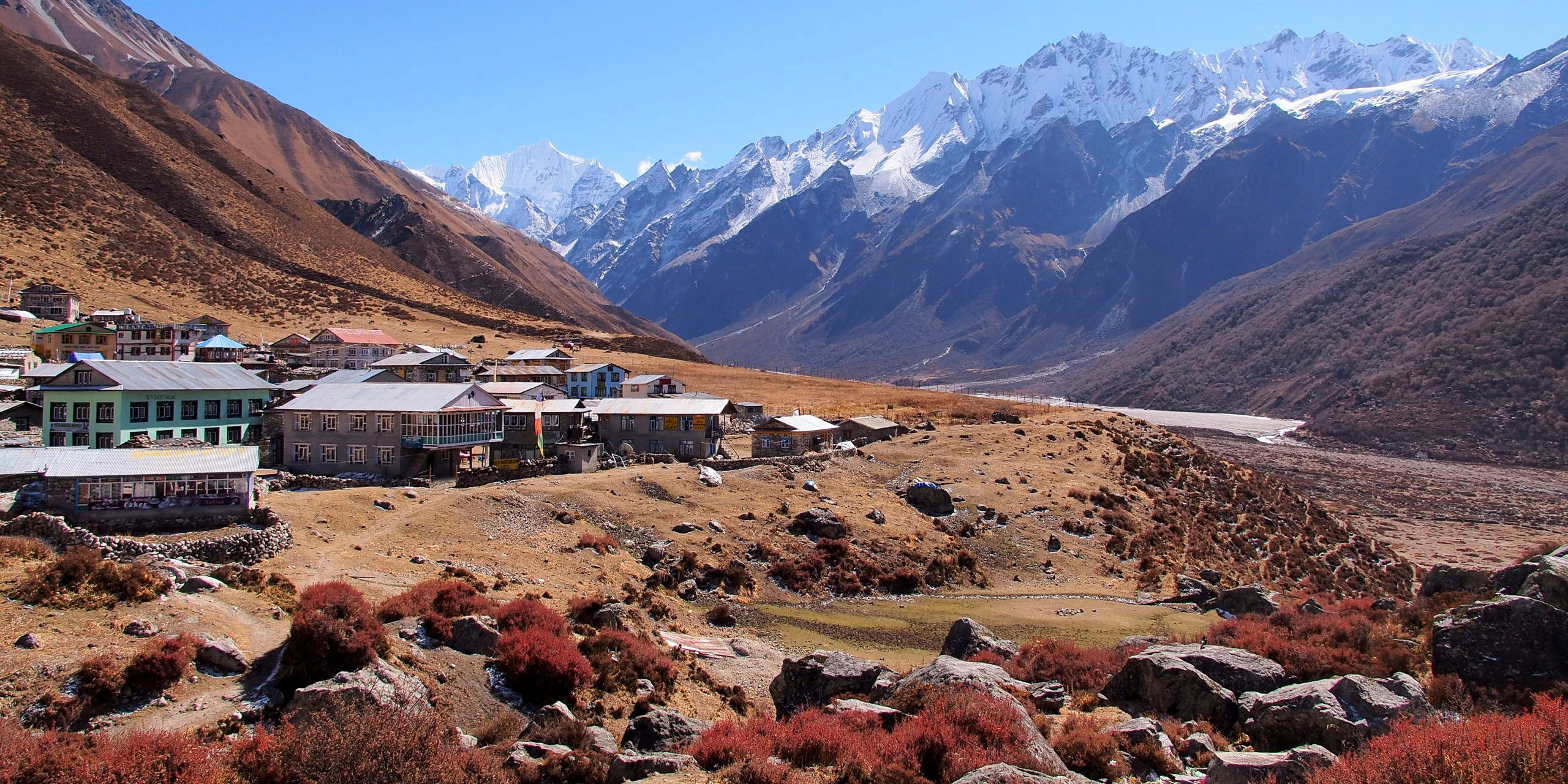
Key Features of the Langtang Valley Trek
-
Duration: Typically, the trek can be completed in 7 to 12 days, making it an excellent option for those with limited time.
-
Altitude: The highest point of the trek is Kyanjin Ri (4,773 meters or 15,659 feet), which offers panoramic views of the Langtang range.
-
Difficulty: It is considered a moderate trek, suitable for most fitness levels but still requires preparation for high altitude and walking in rugged terrain.
Route Highlights
-
Syabrubesi: The starting point for most treks into the Langtang Valley, accessible by a scenic drive from Kathmandu.
-
Langtang Village: Unfortunately destroyed in the 2015 earthquake and since rebuilt, this village is a key stop for trekkers heading deeper into the valley.
-
Kyanjin Gompa: The last village in the valley, known for its ancient monastery and the nearby cheese factory, producing cheese from yak milk.
-
Kyanjin Ri and Tserko Ri: Popular day hikes from Kyanjin Gompa offer breathtaking views of Langtang Lirung, Langtang Ri, and other surrounding peaks.
-
Local Culture: The region is home to the Tamang people, whose culture, language, and religion are similar to the Tibetan culture, providing a rich cultural experience alongside the natural beauty.
Best Time to Trek: The Langtang Valley Trek is best undertaken during the autumn (September to November) and spring (March to May) seasons. Autumn provides clear skies, stable weather, and the best mountain views, making it an ideal time for trekking.
The Langtang Valley Trek not only offers stunning Himalayan scenery but also an intimate look at the lives of the local Tamang people, making it a rewarding experience for those looking to combine mountain adventure with cultural immersion.
Manaslu Circuit Trek
The Manaslu Circuit Trek is a remarkable journey around the world’s eighth-highest mountain, Mount Manaslu, offering a more secluded and untouched path compared to Nepal’s more frequented trekking routes. This trek is known for its stunning landscapes that include high mountain passes, deep valleys, and ancient cultures, providing a truly adventurous experience in the Himalayas.
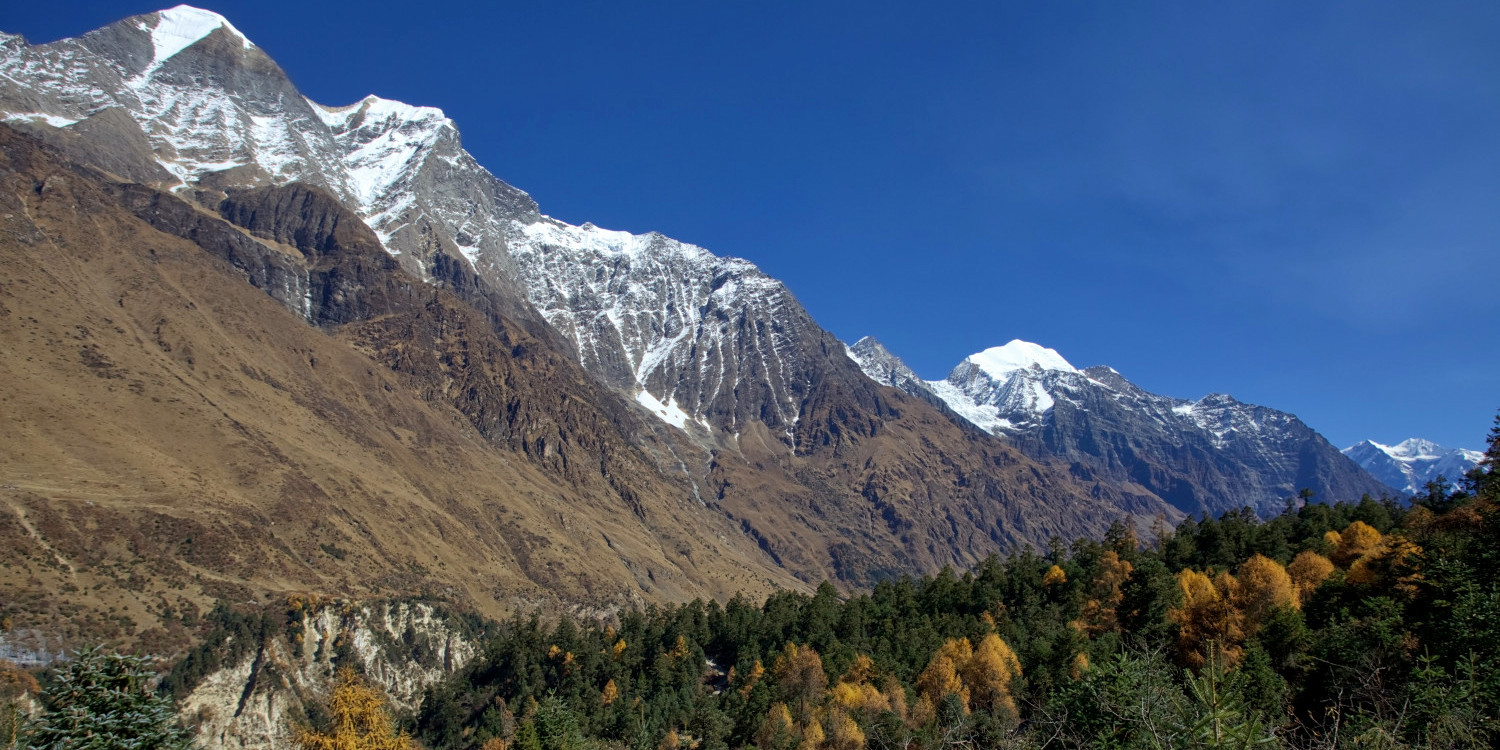
Key Features of the Manaslu Circuit Trek
-
Duration: The trek typically takes about 14 to 20 days, depending on the chosen itinerary and walking pace.
-
Altitude: The highest point on the trek is the Larkya La Pass, which reaches an elevation of 5,106 meters (16,752 feet).
-
Difficulty: It is considered challenging due to its length, high altitude, and remote nature, requiring good physical fitness and trekking experience.
Route Highlights
-
Arughat or Soti Khola: Most treks start from one of these towns, accessible by road from Kathmandu, and immediately immerse trekkers in rural Nepalese life.
-
Jagat, Deng, and Namrung: These villages provide fascinating insights into the local culture and are key stops for acclimatization and experiencing local hospitality.
-
Samagaon and Samdo: Near the Tibetan border, these villages offer a glimpse into the Tibetan-influenced lifestyle of the region’s inhabitants.
-
Larkya La Pass: Crossing this high mountain pass is a highlight of the trek, offering dramatic views of the Himalayas, including Manaslu itself.
-
Bhimtang: After crossing Larkya La, trekkers descend to this beautiful village, which provides stunning views of Mount Manaslu and surrounding peaks.
Best Time to Trek: The Manaslu Circuit Trek is best undertaken during the autumn (September to November) when the weather is most stable and the skies are clear, offering the best views of the mountains. Spring (March to May) is also a good time, with warmer temperatures and the added beauty of blooming flowers at lower altitudes.
The Manaslu Circuit Trek offers an incredible opportunity to explore one of the less traveled areas of Nepal, providing a unique and profound trekking experience set against some of the most spectacular backdrops in the Himalayan range. This trek is perfect for those looking for a challenging adventure away from the more crowded trails.
Upper Mustang Trek
The Upper Mustang Trek explores a region in Nepal that is unlike any other, characterized by its desert-like landscapes, ancient Tibetan culture, and the mystical allure of the once-forbidden kingdom of Lo. This trek provides a stark contrast to the lush greenery typically associated with Nepal, offering insights into the arid, windswept valleys and the deeply entrenched Tibetan traditions of the Upper Mustang region.
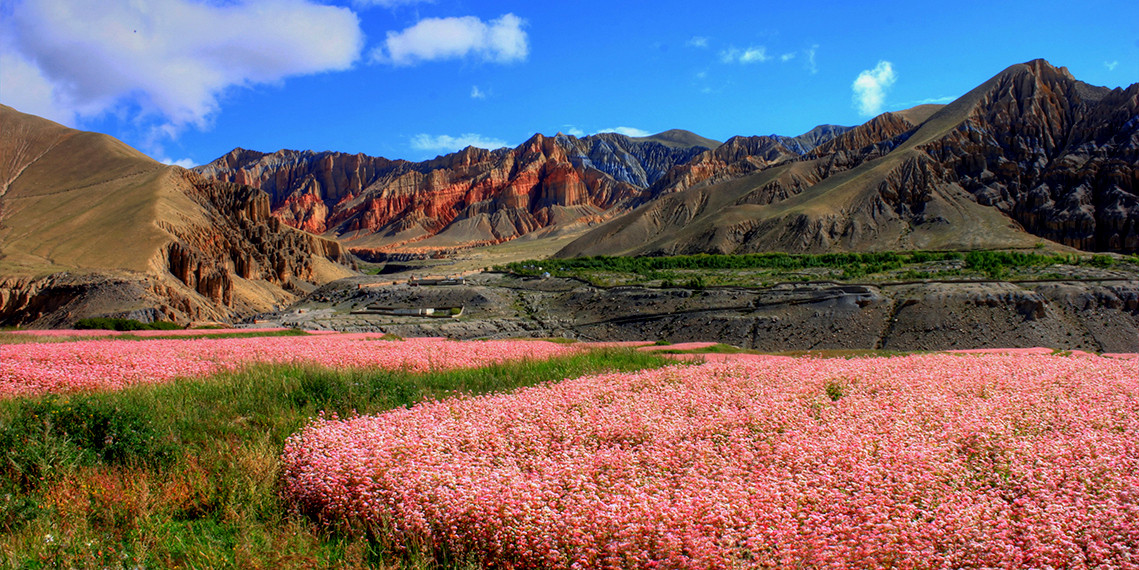
Key Features of the Upper Mustang Trek
-
Duration: The trek generally takes about 10 to 14 days, depending on the starting point and trekking pace.
-
Altitude: The trek reaches its highest point at Lo Manthang, which is around 3,840 meters (12,600 feet).
-
Difficulty: It is considered moderate in terms of difficulty. The trek does not involve high mountain passes or particularly strenuous sections, making it accessible to trekkers who can handle the basic demands of daily long walks.
Route Highlights
-
Jomsom: Starting point for most treks into Upper Mustang, accessible by flight or a long drive from Pokhara.
-
Kagbeni: The gateway to Upper Mustang, known for its ancient monastery and traditional mud-brick houses.
-
Chele, Syangboche, and Dhakmar: Villages along the route that offer unique landscapes and the opportunity to see sky caves, ancient monasteries, and bright red cliffs.
-
Lo Manthang: The walled capital of the former Kingdom of Mustang. Here, trekkers can explore royal palaces, monasteries, and a vibrant local culture that has retained its traditional Tibetan roots.
-
Tiji Festival: If timed right, trekkers can witness the Tiji Festival in Lo Manthang, a three-day ritual known for its colorful dances and costumes, which celebrates the myth of a son who had to save the Mustang kingdom from destruction.
Best Time to Trek: The Upper Mustang Trek is best undertaken from May to October. Unlike other parts of Nepal, Upper Mustang lies in the rain shadow of the Himalayas, making it a great monsoon trekking destination as it remains largely dry during this period.
The Upper Mustang Trek offers a unique opportunity to step back in time and experience a way of life that has remained unchanged for centuries. The stark, beautiful landscapes combined with the rich history and culture of the region make this trek a memorable adventure for those looking to explore the less frequented paths of Nepal.
Poon Hill Trek
The Poon Hill Trek, also known as the Ghorepani Poon Hill trek, is one of the most accessible and popular trekking routes in the Annapurna region of Nepal. Renowned for its stunning panoramic views of the Himalayas and relatively easy trails, this trek is especially well-suited for beginners or those looking for a short but rewarding trekking experience.
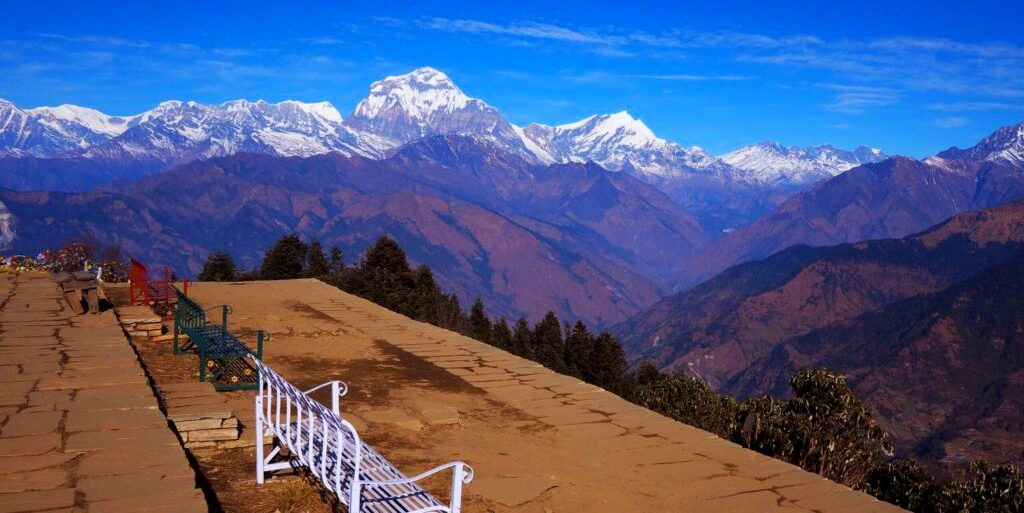
Key Features of the Poon Hill Trek
-
Duration: Typically, this trek can be completed in about 4 to 5 days, making it an ideal choice for those with limited time.
-
Altitude: Poon Hill itself stands at 3,210 meters (10,532 feet), which provides spectacular sunrise and sunset views without the need for extreme altitude acclimatization.
-
Difficulty: It is considered easy to moderate, accessible to most people with average fitness levels.
Route Highlights:
-
Nayapul: The common starting and ending point for the trek, just a short drive from Pokhara.
-
Ulleri: A large Magar village which is often the first night's stop and features a steep climb that tests the trekker’s stamina early in the journey.
-
Ghorepani: A picturesque village nestled in the mountains, which serves as the base for the early morning hike to Poon Hill. It’s also an excellent spot to interact with locals and other trekkers.
-
Poon Hill: The pinnacle of the trek, offering 360-degree views of more than 20 high peaks including Dhaulagiri, Annapurna South, Machapuchare (Fishtail Mountain), and others.
-
Ghandruk: A beautiful village known for its traditional houses and the rich culture of the Gurung people, offering another layer of cultural experience on the descent.
Best Time to Trek: The Poon Hill Trek is best undertaken during the spring (March to May) and autumn (September to November) seasons. These months offer clear skies, stable weather, and the best mountain views. However, the trek can also be done during winter if you are prepared for colder conditions.
The Poon Hill Trek is particularly famous for its breathtaking sunrise views over the Himalayas, which provide a spectacular natural display of color and light. It's an excellent introduction to Himalayan trekking, providing a blend of natural beauty and cultural richness over just a few days.
Gokyo Lakes Trek
The Gokyo Lakes Trek during autumn, from late September to November, is a remarkable journey that offers an alternative to the classic Everest Base Camp trek, with its own unique set of breathtaking views and experiences. This trek takes you through the heart of the Khumbu region to the serene Gokyo Valley, home to the highest freshwater lake system in the world. Here’s why autumn is the perfect season for the Gokyo Lakes Trek:
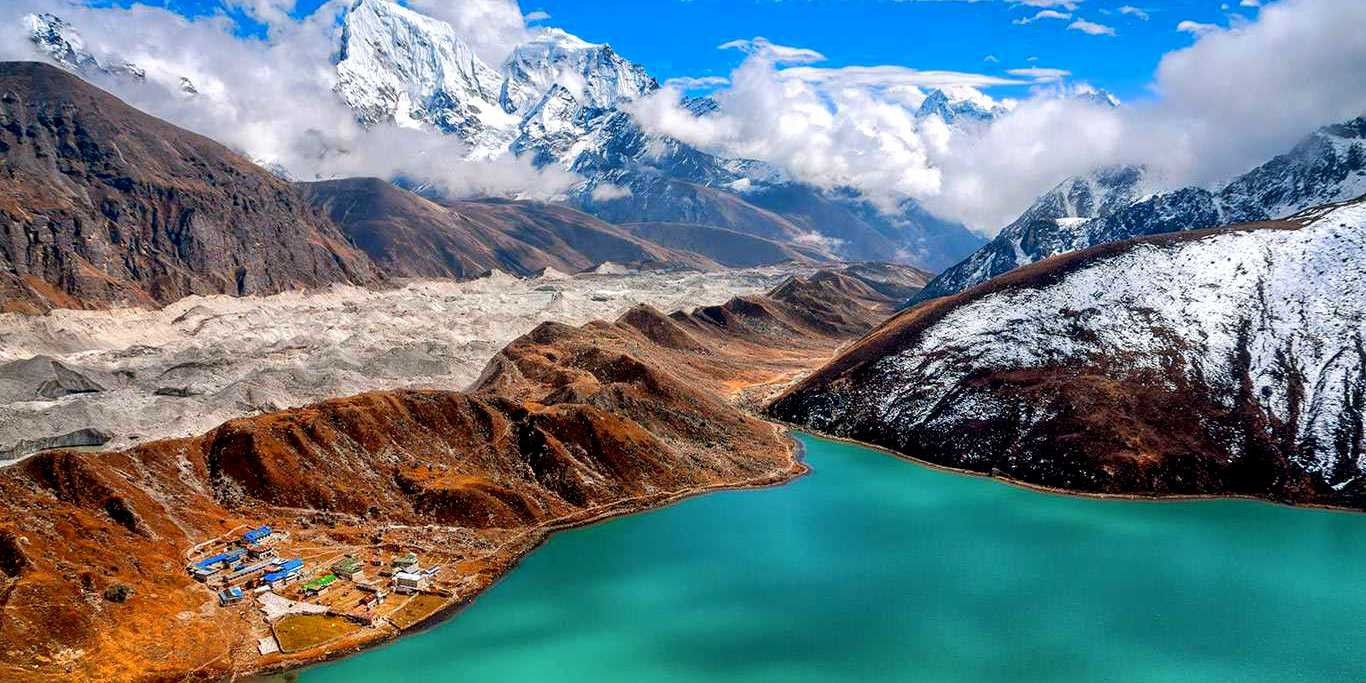
Key Features of the Gokyo Lakes Trek
-
Duration: Typically, the trek can take about 12 to 15 days, depending on the starting point and whether extensions or variations are included.
-
Altitude: The trek reaches its highest point at Gokyo Ri, which is 5,357 meters (17,575 feet) above sea level.
-
Difficulty: It is considered moderate to challenging, primarily because of its high altitude and the length of the trek.
Route Highlights
-
Lukla: Starting point for most treks in the Everest region, with a short but thrilling flight from Kathmandu.
-
Namche Bazaar: The main gateway to the high Himalayas, providing a chance for acclimatization and exploration of the local Sherpa culture.
-
Dole and Machhermo: Smaller villages along the route that offer unique insights into the high-altitude lifestyles and natural beauty of the region.
-
Gokyo Lakes: A system of six spectacular turquoise lakes, which are among the highest freshwater lake system in the world, providing idyllic settings and tranquil views.
-
Gokyo Ri: Offers an unforgettable sunrise view with sweeping panoramas of Everest, Lhotse, Makalu, and Cho Oyu - four of the highest peaks in the world.
-
Ngozumpa Glacier: The longest glacier in the Himalayas, providing dramatic landscapes and a rugged backdrop to the trek.
Best Time to Trek: The Gokyo Lakes Trek is best done in the spring (March to May) and autumn (September to November) seasons. These months feature stable weather, clear skies, and the most favorable conditions for trekking and photography.
The Gokyo Lakes Trek is an exceptional journey that not only challenges trekkers physically but also rewards them with some of the most magnificent and less frequented views in the Everest region. It's a perfect trek for those looking to experience the beauty of the Himalayas in a more serene setting.
Tips for Autumn Trekking in Nepal: The Best Season to Trek in Nepal
Trekking in Nepal during autumn offers the clearest skies and the most stable weather conditions, making it the ideal time for hikers to enjoy the majestic Himalayan landscapes. Here are some essential tips to ensure a successful and enjoyable autumn trekking experience in Nepal:
-
Choose the Right Trek: Select a trek that matches your fitness level, experience, and interests. Popular treks like the Everest Base Camp, Annapurna Circuit, and Langtang Valley are fantastic in autumn, but also consider less crowded options like Manaslu Circuit or Upper Mustang for a more secluded experience.
-
Book in Advance: Autumn is the peak season for trekking in Nepal. Ensure that flights, accommodations, and guides are booked well in advance to avoid the last-minute rush and potential price hikes.
-
Prepare for Cold Nights: Even though the days are sunny and warm, temperatures can drop significantly at night, especially at higher altitudes. Pack adequate warm clothing, a good quality sleeping bag rated for low temperatures, and layer your clothes to adjust to changing conditions.
-
Pack Wisely: Essential items include a sturdy pair of hiking boots, thermal layers, waterproof and windproof jackets, gloves, a hat, and sunglasses. Also, bring a first aid kit, water purification tablets, and sufficient snacks for energy.
-
Acclimatize Properly: Altitude sickness can affect anyone, regardless of their fitness level. Include adequate acclimatization days in your itinerary, especially if trekking above 3,000 meters. Listen to your body, stay hydrated, and do not rush your ascent.
-
Hire a Guide: Even if you are an experienced trekker, hiring a local guide can enhance your trekking experience. Guides offer valuable insights into the local culture, traditions, and landscapes, and ensure your safety on the trail.
-
Respect Local Traditions: Autumn coincides with major Nepali festivals like Dashain and Tihar. Participate in the celebrations if you can, but also respect local customs and traditions. Dress modestly, ask permission before taking photographs, and be mindful of local etiquette.
-
Stay Connected: While many trekking areas now have mobile coverage, it can be spotty. Consider renting a satellite phone if you anticipate being in very remote areas, or ensure you have local SIM cards with data for areas with coverage.
-
Insurance: Ensure you have comprehensive travel insurance that covers high-altitude trekking, medical emergencies, and evacuation. This is crucial, as evacuation by helicopter can be extremely expensive.
-
Environmental Considerations: Preserve the natural beauty of Nepal by minimizing your environmental impact. Dispose of waste properly, use biodegradable products, and avoid plastic as much as possible.
Following these tips will help you have a safe, enjoyable, and respectful trekking experience in Nepal during the beautiful autumn season.
Temperature and Weather Conditions in Autumn
Autumn in Nepal, spanning from late September to November, offers particularly favorable temperature and weather conditions for trekking:
Temperature Range
-
Daytime Temperatures: During the day, temperatures can be quite pleasant, generally ranging between 12°C to 20°C (54°F to 68°F) at higher altitudes. At lower altitudes, temperatures can be warmer, sometimes reaching up to 25°C (77°F).
-
Nighttime Temperatures: As night falls, temperatures at higher altitudes can drop significantly, often falling below freezing, especially as you approach November and higher elevations.
Weather Conditions
-
Stability and Clarity: Autumn is marked by stable weather with very little precipitation. The skies are usually clear, providing excellent visibility, which is ideal for mountain treks where views are a significant part of the experience.
-
Minimal Rainfall: Following the monsoon season, the likelihood of rain decreases substantially in autumn, making the trekking routes less slippery and reducing the risks associated with landslides and floods.
-
Wind: There can be occasional gusts, particularly at higher altitudes, but generally, the wind is not as severe as in other seasons.
Advantages for Trekkers
-
Optimal Hiking Conditions: The moderate daytime temperatures and the dry weather make long trekking days more comfortable and enjoyable.
-
Better Acclimatization: The cooler temperatures at higher elevations during autumn are conducive for acclimatizing to the altitude, reducing the potential risks associated with altitude sickness.
-
Pleasant Nights: While nights are cold, they are usually clear and calm, providing a serene end to active days of hiking.
These conditions contribute to making autumn the most popular and recommended season for trekking in Nepal, offering both spectacular natural beauty and a comfortable trekking environment.
Autumn trekking in Nepal is a transformative experience that combines the best of Himalayan beauty, cultural richness, and ideal trekking conditions. From the breathtaking vistas of the Everest Base Camp to the unique landscapes of the Upper Mustang, autumn presents an unparalleled opportunity to explore some of the most stunning and diverse terrains in the world. With its clear skies, moderate temperatures, and festive atmosphere, this season offers both novice and experienced trekkers the chance to fully immerse themselves in the wonders of the Nepalese Himalayas. As you plan your journey, remember to respect local customs, prepare adequately, and choose the right trek to match your abilities and interests. Whether you're looking for adventure, solitude, or spiritual enrichment, autumn in Nepal provides a perfect backdrop for an unforgettable trekking experience.
FAQs for Autumn Trekking in Nepal: The Best Season to Trek in Nepal
Q: Why is autumn considered the best season for trekking in Nepal?
A: Autumn is ideal due to its stable weather, clear skies, and moderate temperatures, which follow the monsoon season. This period offers excellent visibility for mountain views and coincides with colorful local festivals like Dashain and Tihar, enriching the cultural experience of trekkers.
Q: What are some popular treks to do in Nepal during autumn?
A: Popular autumn treks include the Everest Base Camp, Annapurna Circuit, Annapurna Base Camp, Langtang Valley, Manaslu Circuit, Upper Mustang, Poon Hill, and Gokyo Lakes Treks.
Q: What should I pack for an autumn trek in Nepal?
A: Essential items include a high-quality sleeping bag, layered clothing for varying temperatures, waterproof and windproof jackets, durable trekking boots, a hat, gloves, sunglasses, a first aid kit, sunscreen, water purification tablets, and trekking poles.
Q: Do I need a guide for trekking in Nepal?
A: While not compulsory for all treks, a guide is highly recommended for navigating remote or complex routes. Guides provide valuable local knowledge, enhance safety, and help with logistical aspects such as accommodation and permits.
Q: How do I prepare for high altitude trekking in Nepal?
A: Prepare by incorporating acclimatization days into your schedule, staying hydrated, avoiding alcohol, and ascending gradually. Being aware of the symptoms of altitude sickness and how to treat them is crucial.
Q: What are the risks of autumn trekking in Nepal?
A: The primary risks include altitude sickness, sudden weather changes, and potential physical injuries. These risks can be minimized by preparing adequately, staying updated on weather forecasts, and following established safety protocols.
Q: Is travel insurance necessary for trekking in Nepal?
A: Yes, travel insurance is essential. Ensure your policy covers high-altitude trekking up to the highest altitude you plan to reach, and includes provisions for helicopter rescue and medical treatment.
Q: How can I ensure I respect local customs during my trek?
A: Respect local customs by dressing modestly, asking for permission before taking photographs, being respectful at religious sites, and engaging politely with locals. Learning basic Nepali phrases can also enhance your interaction.
Q: Can I trek in Nepal if I’m a beginner?
A: Yes, there are beginner-friendly treks such as the Poon Hill Trek. These treks are less demanding but still offer magnificent views and cultural experiences. Maintaining a good fitness level is still important.
Q: What steps can I take to minimize my environmental impact?
A: Follow Leave No Trace principles by carrying out all trash, using water responsibly, avoiding single-use plastics, and staying on established trails. Opt for eco-friendly lodges and services to support sustainable tourism practices.
For the Nepal tour, please click here.
If you are looking for different kinds of Nepal Tours or Trekking Packages, feel free to contact us.
